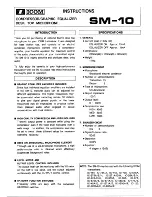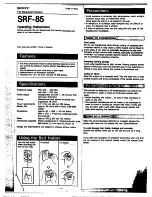
43
B2-GRQ-OpGuide-v9-031020.pmd
S
ECTION
N
INE
: S
UGGESTIONS
FOR
O
PTIMAL
U
SE
OF
THE
G
RAPHI
-Q2
9.4.1.3. Center Cluster Speakers
Center cluster speakers offer several advantages over systems that have speakers mounted on the
sides. The most obvious advantage is that the distance to the closest and most distant locations in the
audience is often almost equal, so most listeners hear about the same level. Center clusters also offer
two other advantages regarding visual imaging.
Studies have shown that people can detect even small horizontal changes in the direction of a sound
source, but vertical shifts are much less noticeable. This suggests that the sound from center-cluster
speakers is more likely to be visually aligned with the performer than loudspeakers placed on each side
of the stage.
All those in the audience who are closer to the performer than the center cluster will hear the direct sound
from the performer before they hear the sound from the loudspeakers. This makes the sound seem
to come from the performer, not the loudspeakers (see
Section 9.4.3
: Precedence Effect).
9.4.2. Comb Filter Distortion
Many who took high school sci-
ence may remember ripple tank
experiments where waves are
generated from two separate
point sources. The waves from
each source combine to form
visible interference patterns. In
some places the wave crests
and troughs are in phase so
they combined to make a larger
wave. In other places the crests
are out of phase, so the crest of
one wave source is canceled
by the trough of the other.
Ripple tank experiments show
the interference patterns are
strongest when the amplitudes
of the waves from each source
are equal.
A similar interference occurs in sound systems when a signal is delayed and mixed back into the original
signal. These interference patterns are called COMB FILTERS because their frequency response plots
look like the teeth of a comb (see Delay Figs. 1 & 2). There are a number of common situations that
cause comb filters. For ex-
ample, when the program is
played through two loudspeak-
ers, the loudspeaker that is far-
ther away interferes with the
closer loudspeaker. Comb fil-
ters are also created when a
performer is picked up by two
microphones, one closer than
the other. You even introduce
comb filters by mixing digital
effects back into the “dry” sig-
nal at the mixer’s effects loop.
Delay Figure 1: COMB FILTERS.
Input signal mixed with a 2 msec. delayed
signal. (Both signals have the same
amplitude. Maximum filter gain is +6 dB,
and maximum depth is negative infinity.)
Delay Figure 2: COMB FILTERS.
Input signal mixed with a 2 msec. delayed signal. (Delayed signal has 10 dB less
amplitude. Max. filter gain is +2.5dB, and max. depth is -3.) Reducing the amplitude
of the delayed signal reduces the comb filters' effect.














































